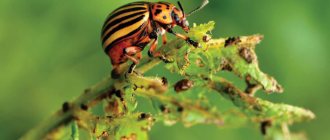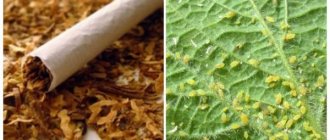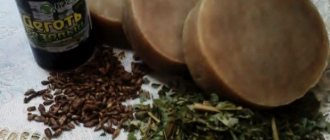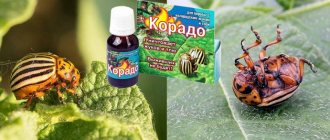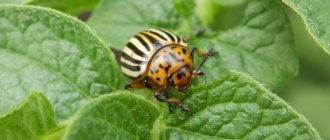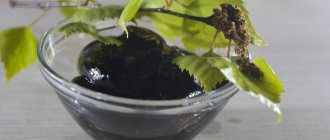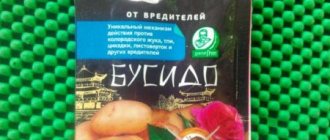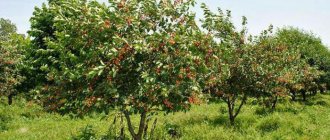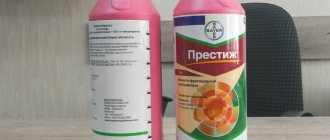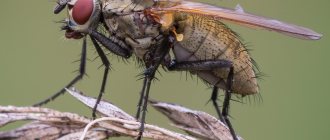Tar is a safe and crop-harmless substance that allows you to overcome ants and other insect pests in the garden. Its use is justified in many cases and is not inferior in its effectiveness to toxic pesticides. An advantageous difference is that tar does not affect the quality of the crop in any way; vegetables can be eaten almost immediately after processing.
Natural properties of birch tar
Tar is a product that has been extracted by tar craftsmen from different types of wood since ancient times. If wood or birch bark was used as a raw material, the tar was called “birch bark”. Abroad it was called “Russian oil”.
Externally, birch tar indeed resembles liquid oil of a greenish-black color. With its help, in Russia they tanned leather, impregnated wooden structures during construction, and lubricated horse harnesses. Tar has a strong antiseptic effect, so it is often used in folk medicine to this day. This same quality allows the successful use of birch bark to protect plants from bacterial and fungal infections.
Chemically, tar is a mixture of various organic compounds:
- phenol;
- paraffin;
- cresol;
- benzene;
- resins;
- tannins;
- alkaloids, etc.
Many of these substances in their chemically pure form are highly toxic, but the tar itself does not harm the environment at all and does not have a harmful effect on plants.
The benefits of tar and the advantages of its use in the garden
Birch tar is a natural and safe remedy that has long been successfully used in households, folk medicine, cosmetology, gardening and horticulture due to its many beneficial properties (antiseptic, antiparasitic, antimicrobial). It contains resins, paraffin, organic acids, phytoncides, natural antiseptics (phenol), guaiacol...
Of course, we do not urge you, following the example of your ancestors, to lubricate cart wheels with tar or tan leather with it, but, believe me, it is very advisable to use it in the garden. Due to its sharp, specific odor, it works as an excellent repellent for harmful insects and small mammals, and the healing properties of tar help plants fight various diseases.
The use of birch tar on the site, compared to conventional pesticides, has many advantages:
the drug is safe to use for humans; works against a wide group of garden and vegetable pests - from mammals to insects; does not cause addiction to insects; does not destroy pests, but only scares them away, which is especially important in the case of forest mammals that are “undesirable” only on a personal plot; does not require complex equipment for use or even self-production (see below); can be used in several ways at once (including without contact with the plant itself, so as not to have a negative effect on it); has a long-term protective effect - from three to four weeks to the full growing season.
The effect of birch tar on insects
The distinctive smell, familiar to modern people from Vishnevsky’s ointment, gives tar repellent properties, which is why shepherds, fishermen and hunters have long smeared themselves with it to repel mosquitoes and midges. This is what justifies the feasibility of using birch bark to control plant pests.
However, tar is not only an effective repellent. It contains a lot of paraffin, which clogs the spiracles of insects upon direct contact. To combat larvae that do not have a hard chitinous shell, the irritating effect of phenol and cresol is also relevant. These same substances, evaporating, enter the respiratory system of pests, poisoning them.
Important! Since tar can kill bacteria and fungi, it should not be used simultaneously with EM preparations, fungicides and insecticides of biological origin. After tar treatment, about a week must pass before microbiological agents can be used.
Mechanism of action of tar
Tar is not such a harmless substance. It must be applied skillfully and on time, clearly understanding the mechanism of action of the product on pests and plants.
Pest Control
Birch tar acts as a repellent, but is not an insecticide. The product repels insects with a strong unpleasant odor without killing them. Once the scent wears off, the pests may return.
The use of birch tar in gardening and gardening is effective if the processing time is calculated correctly. Often, it is not the insects themselves that pose a danger to plants, but their larvae or nymphs. By scaring away pests during the egg laying period (it does not last long), you can protect the plantings from many troubles. The product protects vegetable and garden crops in the country and reduces the insect population.
The unpleasant smell of tar quickly disappears; a person stops feeling it after a few days. But many insects have a more sensitive sense of smell.
For a period of 30 days or more, a specific smell will repel:
Less than 30 days in the absence of rain, the tar solution acts on:
- Colorado potato beetle;
- phytophagous flies (onion, cabbage, carrot);
- beetles (sawflies, wireworms);
- pest butterflies:
- cabbage whites;
- gooseberry moth;
- hawthorn;
- plum and apple moth.
A single application is usually enough to prevent pests from laying eggs.
Unfortunately, tar is ineffective as a remedy for:
- aphids;
- ants;
- weevils;
- larvae of some other beetles.
These insects do not have very sensitive olfactory organs, the smell affects them for several days - you need to constantly update the source of the “aroma”, or use other means.
Protection from diseases
Birch tar is rarely used in the garden or garden to combat diseases, although it has beneficial properties for plants:
- wound healing,
- antimicrobial,
- antiseptic.
Plants are treated against powdery mildew:
- a single spraying will serve as a preventive measure in rainy summers;
- three-time treatment, with an interval of 7-10 days, will help cope with advanced disease.
To prevent late blight, the soil is shed before planting some crops:
- potatoes;
- tomatoes;
- other nightshade crops.
This destroys pathogenic spores in the ground, but cannot guarantee that the fungus will not penetrate into the garden bed from a neighboring area.
Toxicity to humans and plants
It is impossible to say that tar is absolutely harmless - it contains:
All of them are toxic and have a negative effect on humans. Of course, the highest concentration of harmful substances is in sapropel tar. The drug made from birch bark and wood contains much less of them. The purest, birch bark tar, is expensive, is usually used in the medical and perfume industries, and is rarely used in the garden. It is the least effective against pests and has a weak odor.
After dilution, toxicity is reduced to class 4 (low hazard). The respirator can be replaced with a gauze bandage, and people who are not particularly sensitive take off their gloves - the solution that gets on the skin promotes wound healing.
It makes no sense to greatly dilute tar to reduce toxicity - reducing the concentration of the substance makes the odor weak. Processing plants becomes useless.
Advantages and disadvantages
The use of birch tar to protect gardens and vegetable crops from pests has advantages and disadvantages.
| pros | Minuses |
|
|
Advantages and disadvantages of birch tar
If you compare tar with chemical insecticides, you can notice both the advantages of this product and several disadvantages:
| Advantages (+) | Flaws (-) |
|
|
Plants based on flowers and fruits cannot be treated with tar preparations. If you do this by flowers, pollination may not take place, since the bees will not land on them. If you spray the fruits, they will acquire a characteristic unpleasant odor.
From hawthorn
The hawthorn butterfly is not dangerous to plants, however, its larvae can damage a large number of leaves of cherry, apple, rowan, pear and other trees in a short period of time. They destroy not only leaves, but also flowers. Hawthorn overwinters on trees in cobwebs or on last year's dried leaves. In the spring, with the onset of warmth, they wake up and begin to eat young buds. At the end of May, pupae form from the caterpillars and grow within two to three weeks. Butterflies fly out of the pupae and then lay eggs on the leaves. The eggs develop within 14-18 days from which caterpillars emerge again. In order to prevent the growth and reproduction cycle of hawthorn, you need to treat the plants with a solution of tar, soap and water. This procedure should be done at the same time that trees are treated to combat codling moth.
Insect pests sensitive to birch tar
Despite the fact that tar preparations act on all insects, their sensitivity to them varies:
| High sensitivity | Average sensitivity | Weak sensitivity |
|
|
|
By weak sensitivity it should be understood that the effect of tar treatment will occur, but will not last long. Typically, the pests can return in less than a month, especially if the weather is cool.
Birch bark successfully combines the properties of a fungidide, antiseptic, repellent and insecticide.
Who does tar scare away?
As a repellent, tar in the garden and garden is most effective against objects of elimination that have a keen sense of smell and wholly or partially lead an underground lifestyle, because In the soil, the active ingredients of tar remain longer. These factors mutually reinforce each other. Based on this, the repellent effect of tar on different groups of pests is divided into 3 categories:
- Severe – lasts more than 30 days. As a rule, one treatment per season is enough for the objects of elimination to remove themselves from the site in all directions;
- Medium – lasts up to 30 days, but is stable;
- Mild – lasts less than 30 days. In cold weather it weakens or stops.
Tar drives away mole crickets, moles, voles and gypsy moths most strongly, see figure:
The latter does not live underground, but its males have an ultra-fine sense of smell: they find females by smell from kilometers away. The tar stench disrupts the search for mating partners, and the population in the surrounding area dies out. But, if you also have large, beautiful and harmless pinnate butterflies (for example, large night peacock eye - pear peacock eye, Artemis peacock eye, ocellated toothed one), then they too will disappear. You can also not expect visits from specialized pollinators such as hawkmoth butterflies after treating the area with tar. You can get rid of mole crickets with tar at once for the entire season, see for example. video:
Video: tar against mole crickets and mice
Medium tar drives away Colorado potato beetles, white butterflies (cabbage moths), codling moths, moths, phytophagous flies (onion flies, cruciferous flies), larvae of click beetles (wireworms), sawflies, other rodents, hares and slugs, see figure:
The use of tar against these pests is completely justified, because allows, if not to expel them completely, but to greatly reduce the dose of pesticides and the costs of them. How to use tar to make it easier to fight the Colorado potato beetle, see the story:
Video: processing potatoes with tar
Finally, tar weakly repels ants, elephant beetles and weevils, adult click beetles and bronze beetles, see next. rice. Fighting these pests with tar alone is unlikely to be successful. Ants - foragers and herders of aphids - may die from tar, but their loss for the anthill as a “superorganism” is, in general, no more sensitive than cutting hair or nails for us. It is possible to expel ants from a site with tar only if the anthill is outside its boundaries and measures are taken to combat aphids. Then the “superorganism” will redirect the foragers to another place, and force the shepherds to transfer the aphids there.
Analysis of methods of pest control using tar
One of the advantages of tar is that it can be used to protect plants from pests in different ways:
- Repellent belts. They are used to repel pests that rise from the ground from trees. The tree trunk is tied with a piece of plastic film. A strip of rags is soaked in tar and placed on top of the film.
- Repellent banks. Used to repel flying pests from trees and shrubs. Holes are made in empty cans through which a piece of twine is threaded. A rag soaked in tar is placed at the bottom. Banks are hung on branches.
- Scare stakes. Used to repel flying pests from vegetable crops. A rag is wrapped around the end of the stick, dipped in tar, and the stake is inserted into the soil in the garden bed with the rag facing up.
- Processing of planting material. Used to protect potato tubers and onion sets from damage by soil pests. 2 tablespoons of birch bark are mixed in 10 liters of water and planting material is immersed in the resulting solution for 5 minutes.
- Watering. Used to control soil pests. A solution of 1-2 tablespoons of tar and 10 liters of water is poured onto the surface of the soil under the vegetative plants.
- Spraying. Used to repel and destroy pests of leaves and shoots.
The spraying solution is prepared in the same way as for watering, only you need to add an adhesive to it. Regular laundry soap is usually used for this purpose. It can be grated and dissolved in water. A 10-liter bucket requires about a glass of soap.
Tip #1. To better disperse the tar in the water and not stick to the sprayer, you can first stir it in a liter of hot water, and then pour it into the soap solution while stirring in a thin stream.
From cherry weevil
Weevil larvae overwinter in the soil and form dolls that mature before the leaves begin to bloom. Butterflies lay eggs on the back of the leaf along the central vein, 5-10 eggs each. The caterpillars begin to eat the pulp of the leaves, making holes in them. Caterpillars live in groups, which are connected by webs and damage an even larger area of the plant.
The cherry weevil is also known as the cherry sawfly. They begin to get rid of it in early spring from the moment the leaves bloom. At this time, treat the cherries with a solution prepared from a bucket of water, 30 g of grated laundry soap and one tablespoon of tar. After 7-10 days the treatment is repeated.
The use of tar to control various types of pests
Having familiarized yourself with the main methods of using tar, you can decide which of them is suitable for combating a specific pest:
| Pest | Processing method | Frequency of processing |
| Colorado beetle | Spraying | As needed, at intervals of 1 time every 2 weeks. |
| Medvedka | Pre-planting treatment of tubers | Once immediately before landing |
| Watering | 1-2 times per season | |
| Aphids, cruciferous flea beetles, spider mites, leaf-eating caterpillars, slugs | Spraying | 1-2 times per season |
| Carrot and onion flies, wireworms, May beetles | Watering | 2 times per season |
| Flower beetle, thrips and moth | Spraying | 1 time per season |
| codling moth | Spraying | 1 time per season |
Spraying against insects that damage flowers (for example, thrips or apple
To get rid of highly sensitive insects for the entire season, one treatment with birch bark may be enough.
flower beetle weevils), it is advisable to carry out before flowering. The best moment is the inflorescence extension phase. After spraying, it is necessary to hang repellent jars on the branches and make sure that the rags on their bottom do not dry out.
The fight against codling moth caterpillars, which damage almost all tree fruit crops (apple, plum, pear, apricot, peach, quince, etc.), also needs to be carried out comprehensively. In order not to scare away the bees, the treatment is carried out at the end of the flowering phase, when the petals begin to fall off. The crowns of trees are sprayed on the inflorescences and repellent cans are hung on the branches.
To get rid of such a pest as currant bud mite, there is a separate method:
- early in the spring, before the buds awaken, sanitary pruning is performed on the bush;
- prepare a hot solution of 2 tablespoons of tar and 10 liters of water;
- the hot solution is poured into a watering can, and the bush is poured with it directly over the shoots.
Tilling the soil against carrot and onion flies is done in May and June, when these
For spraying plants for the purpose of prevention, an ordinary broom, which is moistened in a bucket of tar solution, is quite suitable.
pests are in the period of flight and oviposition. The carrot bed is spilled with tar solution for the first time during sowing. You need to repeat watering when the third true leaf appears on the seedlings.
To protect onions grown from sets, tar treatment of planting material is useful. Watering such a bed is carried out at the end of May or beginning of June. If onions are grown from nigella by seedlings, two waterings are done - immediately after planting the seedlings and at the beginning of summer.
From spider mites
Mites cannot stand the smell of tar, therefore, it is effectively used to rid plants of them. There is an opinion that spider mites are an insect that attacks indoor and greenhouse plants. However, over time, it adapted to harsher climatic conditions, and began to appear more and more often in open areas, especially on young seedlings. If you see yellowish lines on the sprouts, this is a clear sign of a spider mite settling there. It is necessary to treat diseased seedlings with a solution of birch tar as soon as possible. To make it, mix 100 g of birch tar with seven liters of water and spray all the seedlings with it from a spray bottle. It should be borne in mind that adult mites and their larvae live on the inside of the leaf, so it must be processed with special care.
Purchased products with birch tar
Birch tar is easy to purchase at any garden center or pharmacy. You can also find it in hardware stores, veterinary pharmacies or in regular supermarkets in the form of soap:
| Means | Peculiarities | average price |
| Medical tar | It has a high degree of purification from harmful impurities, therefore it is more transparent in appearance, with a brown tint. | 170 rubles for a 100 ml bottle |
| Veterinary tar | Used to treat wounds on the body of animals, various infectious skin diseases, and hoof injuries. The degree of cleaning is average. | 50-100 rubles per 100 ml bottle |
| Garden tar | Used for adding to garden putties, mixing into whitewash for trees, diluting protective and healing solutions. The degree of cleaning is average. | 260 rubles for a 250 ml bottle |
| Construction tar | Used to impregnate wooden structures and protect them from rotting. The degree of purification is low and has the usual appearance of fresh tar. | 200 rubles per 200 ml jar. |
| Tar soap | Available in the form of bars or in the form of liquid soap. Used as an antibacterial cosmetic. The tar content is low, therefore it has no repellent or insecticidal properties. Can be used as an adhesive or antiseptic. | 32-900 rubles per bar or 80-300 rubles per bottle. |
Any birch bark, regardless of where it was purchased, can be used to protect against pests. The degree of its purification affects mainly the person. It is more pleasant and safer to work with medical tar.
Useful tips
Gardeners note the effectiveness of using tar solution against the Colorado potato beetle. Useful tips will help those who started such processing for the first time.
The main thing is not to overdo it. The above proportions of the composition are quite sufficient to combat the pest; if you overdo it, there is a risk of causing serious harm to the crop. If you water your crops too rarely, the smell will quickly dissipate and the insects will return. Otherwise, there is a risk of destroying the plants, as they will become inedible.
It will be nice if you carry out a joint fight in several areas at once. To do this, you can come to an agreement with your neighbors and join forces.
It should be noted that pest control requires only one method. You should not combine different drugs, since the reaction from their interaction is difficult to predict. In addition, if you combine the use of birch tar and chemicals, the latter can kill the specific smell, and accordingly, the drug will become useless.
If you treat a plant without first removing pests from it, this will also not lead to a positive result.
The beetle will spoil the plantings, guided visually, since it will cease to distinguish odors.
It is also necessary to take precautions. The solution is not applied to fruits that are eaten as it may give them an unpleasant taste
An undiluted substance can cause allergies, so you should think about protective clothing. You should also take care of the safe storage of the substance. When preparing the solution, be sure to remove children and pets from the access area.
To learn how to treat potatoes against the Colorado potato beetle using birch tar, see the following video.
Self-collection of birch tar
Tar helps drive the mole cricket out of the area, scaring off this insect with a delicate sense of smell with its smell.
Tar solutions can be poured into planting holes of tomatoes, peppers, eggplants and cucumbers. You can also get tar yourself, in the old proven way - using a simple tar plant:
- bury a metal can in the ground to collect tar;
- take a metal pan with a diameter larger than the jar and make a hole in its bottom;
- Place rolled fresh birch bark in a saucepan and place it on a buried jar;
- cover the pan and cover the entire structure with sand, earth or cover it with bricks;
- light a fire on the lid of the pan and around it and maintain moderate heat for 2-3 hours.
After the fire burns out, the jar of tar is dug out of the ground, and the product is poured into a dark container with a tight lid. The shelf life of self-extracted tar is unlimited.
From aphids
Aphids are a common pest of garden plants. It settles on almost all cultivated plants, bushes and trees. To fight aphids using a tar solution, mix a tablespoon of tar and 50 g of grated laundry soap into a bucket of water. Treat plants before and after flowering with a spray bottle in the evening. Instead of tar resin, you can use tar soap, which is made from birch tar. To do this, dissolve half a bar of soap in a bucket of warm water and add five tablespoons of tar. This solution is used to treat bushes that are already infected with aphids. Particular attention should be paid to the lower surface of the leaves and young shoots.
Expert on the use of birch tar for pest control
To obtain 0.5 liters of tar, about 2 kg of birch bark is required.
Recently, a complex multi-component product based on tar, developed by the creators of the Internet project “First Countryside”, has become very popular.
Recipe for preparing a solution against pests (click to expand)
First, a mother solution is prepared in a 10-liter bucket of water. The following ingredients are used for this volume of water:
- 1 teaspoon of iodine (find out → the use of iodine / brilliant green as a fertilizer);
- ½ teaspoon boric acid;
- 2 tablespoons of birch tar;
- 2 tablespoons of ammonia;
- 1 teaspoon fir oil;
- 1 glass of laundry soap.
After thorough mixing, the mother liquor is ready. It is added to irrigation water at a rate of 0.5 liters per 10-liter bucket. Treatment is carried out by direct watering on the tops and shoots of plants or by spraying.
“I call this mixture a “remedy for all pests.” If the number of pests is high, treatments should be carried out 3 times with an interval of 5-7 days.”
Olga, video blogger, gardener, editor-in-chief of the First Country project
Experiments using this mixture have confirmed its effectiveness against all types of aphids, raspberry-strawberry weevils, onion and carrot flies, cruciferous flea beetles, spider mites, leaf rollers, cabbage moths, slugs and snails, and all types of caterpillars.
From cabbage fly
The same remedy helps to get rid of psyllids, beet aphids and wireworms. The cabbage fly settles on cruciferous cultivated plants that grow in our plots. These include cabbage, radishes, daikon and others. To get rid of them, you should soak the sawdust in a solution of birch tar. When the sawdust swells, they mulch the soil between the plants, thus repelling cabbage flies, cabbage butterflies or cruciferous flea beetles.
Peculiarities
Birch tar is a viscous, oily mass of dark brown color with a sharp, specific odor. It is obtained from birch bark, which is highly heated in a hermetically sealed container. The result of the oxidation process is a natural substance that has antiseptic, antimicrobial, sanitizing and antiparasitic properties.
Due to this, this product has become unique and has found wide application not only in cosmetology and folk medicine, but also in veterinary medicine and horticulture. This is an excellent biological repellent that repels many different garden pests.
Many may have questions about how to dilute birch tar, or how to spray with tar. Below are the most popular recipes using this unique natural repellent.
Birch tar from aphids
